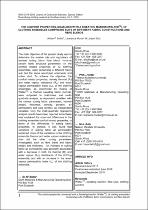 ResearchSpace
ResearchSpace
The comfort properties, measured with a sweating manimin (Walter TM), of clothing ensembles comprising suits of different fabric constructions and fibre blends
JavaScript is disabled for your browser. Some features of this site may not work without it.
- ResearchSpace
- →
- Research Publications/Outputs
- →
- Journal Articles
- →
- View Item
| dc.contributor.author |
Botha, Anton F

|
|
| dc.contributor.author |
Hunter, Lawrance

|
|
| dc.contributor.author |
Britz, L

|
|
| dc.date.accessioned | 2019-02-24T10:24:19Z | |
| dc.date.available | 2019-02-24T10:24:19Z | |
| dc.date.issued | 2018 | |
| dc.identifier.citation | Botha, A.F., Hunter, L. and Britz, L. 2018. The comfort properties, measured with a sweating manimin (Walter TM), of clothing ensembles comprising suits of different fabric constructions and fibre blends. Journal of Consumer Sciences, vol. 3: 13pp | en_US |
| dc.identifier.issn | 0378-5254 | |
| dc.identifier.uri | https://www.ajol.info/index.php/jfecs/article/view/178117 | |
| dc.identifier.uri | http://hdl.handle.net/10204/10723 | |
| dc.description | Paper published in Journal of Consumer Sciences, vol. 3: 13pp | en_US |
| dc.description.abstract | The main objective of the present study was to determine the relative role and importance of worsted suiting fabric fibre blend, vis-à-vis certain fabric structural parameters, on the comfort related properties of 12 clothing ensembles, each comprising a different man’s suit, but the same wool/nylon underwear and cotton shirt. To achieve the objective, the comfort related properties, namely thermal (Rt) and water vapour resistance (Ret) and water vapour permeability index (Im), of the clothing ensembles, as determined by means of WalterTM, a thermal sweating fabric manikin, were subjected to multi-linear and multi-quadratic analysis, as dependent variables, with the various suiting fabric parameters, namely weight, thickness, density, porosity, air permeability and wool content, as independent variables. Only the multi-quadratic regression analysis results have been reported since these best explained the observed differences in the clothing ensemble comfort related properties, in terms of the differences in suiting fabric properties. In general, it was found that variations in suiting fabric air permeability explained more of the variations in the clothing ensemble thermal and water vapour resistance, than did the other suiting parameters investigated, such as fibre blend and fabric weight and thickness. An increase in suiting fabric air permeability was generally associated with a decrease in both the thermal (Rt) and water vapour (Ret) resistances of the clothing ensemble, and with an increase in the water vapour permeability index (Im) of the clothing ensemble | en_US |
| dc.language.iso | en | en_US |
| dc.publisher | AJOL | en_US |
| dc.relation.ispartofseries | Worklist;21475 | |
| dc.subject | WalterTM | en_US |
| dc.subject | Sweating manikin | en_US |
| dc.subject | Fibre type | en_US |
| dc.subject | Clothing comfort | en_US |
| dc.title | The comfort properties, measured with a sweating manimin (Walter TM), of clothing ensembles comprising suits of different fabric constructions and fibre blends | en_US |
| dc.type | Article | en_US |
| dc.identifier.apacitation | Botha, A. F., Hunter, L., & Britz, L. (2018). The comfort properties, measured with a sweating manimin (Walter TM), of clothing ensembles comprising suits of different fabric constructions and fibre blends. http://hdl.handle.net/10204/10723 | en_ZA |
| dc.identifier.chicagocitation | Botha, Anton F, Lawrance Hunter, and L Britz "The comfort properties, measured with a sweating manimin (Walter TM), of clothing ensembles comprising suits of different fabric constructions and fibre blends." (2018) http://hdl.handle.net/10204/10723 | en_ZA |
| dc.identifier.vancouvercitation | Botha AF, Hunter L, Britz L. The comfort properties, measured with a sweating manimin (Walter TM), of clothing ensembles comprising suits of different fabric constructions and fibre blends. 2018; http://hdl.handle.net/10204/10723. | en_ZA |
| dc.identifier.ris | TY - Article AU - Botha, Anton F AU - Hunter, Lawrance AU - Britz, L AB - The main objective of the present study was to determine the relative role and importance of worsted suiting fabric fibre blend, vis-à-vis certain fabric structural parameters, on the comfort related properties of 12 clothing ensembles, each comprising a different man’s suit, but the same wool/nylon underwear and cotton shirt. To achieve the objective, the comfort related properties, namely thermal (Rt) and water vapour resistance (Ret) and water vapour permeability index (Im), of the clothing ensembles, as determined by means of WalterTM, a thermal sweating fabric manikin, were subjected to multi-linear and multi-quadratic analysis, as dependent variables, with the various suiting fabric parameters, namely weight, thickness, density, porosity, air permeability and wool content, as independent variables. Only the multi-quadratic regression analysis results have been reported since these best explained the observed differences in the clothing ensemble comfort related properties, in terms of the differences in suiting fabric properties. In general, it was found that variations in suiting fabric air permeability explained more of the variations in the clothing ensemble thermal and water vapour resistance, than did the other suiting parameters investigated, such as fibre blend and fabric weight and thickness. An increase in suiting fabric air permeability was generally associated with a decrease in both the thermal (Rt) and water vapour (Ret) resistances of the clothing ensemble, and with an increase in the water vapour permeability index (Im) of the clothing ensemble DA - 2018 DB - ResearchSpace DP - CSIR KW - WalterTM KW - Sweating manikin KW - Fibre type KW - Clothing comfort LK - https://researchspace.csir.co.za PY - 2018 SM - 0378-5254 T1 - The comfort properties, measured with a sweating manimin (Walter TM), of clothing ensembles comprising suits of different fabric constructions and fibre blends TI - The comfort properties, measured with a sweating manimin (Walter TM), of clothing ensembles comprising suits of different fabric constructions and fibre blends UR - http://hdl.handle.net/10204/10723 ER - | en_ZA |





